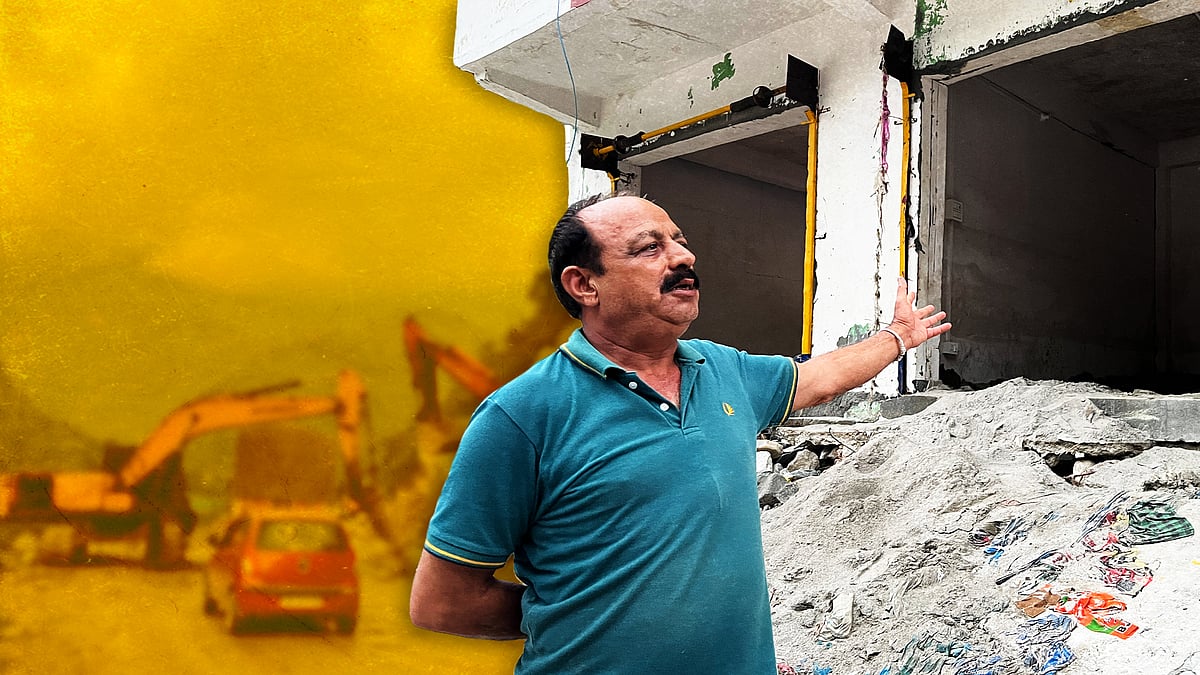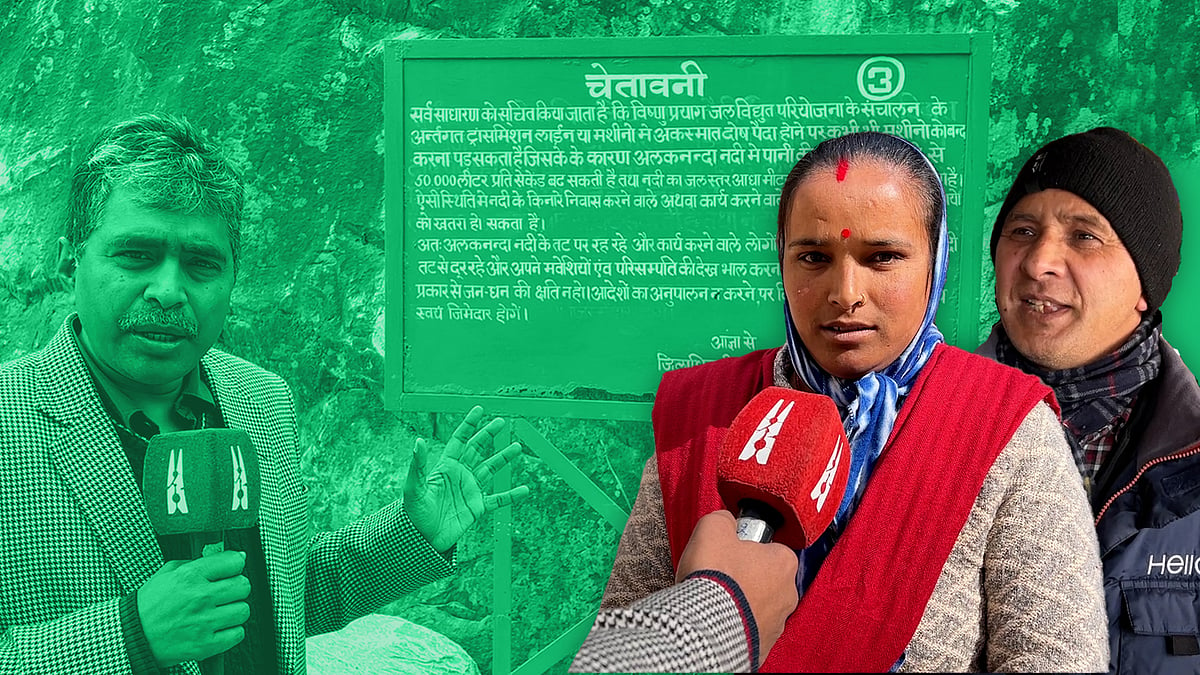‘River didn’t come to us, we went to it’: How NHAI’s ‘all-weather’ highways eroded in Himachal
In the aftermath of the floods, more than 1,200 roads were blocked in the state due to landslide, erosion.
A spate of national highways bending along the Himalayan rivers have cropped up in Himachal Pradesh over the past years. Several of these roads, built by the National Highways Authority of India by cutting up mountains, are deemed “all-weather” – but the recent floods have uncovered a different reality.
The floods that ravaged the state in July this year left over 130 dead, thousands displaced, and more than 1,200 roads blocked due to landslides, erosion and damage. In Kullu district alone, around 170 roads were blocked. The traffic on one of the most high-profile and newly-built highways in Himachal – the Kiratpur-Mandi-Kullu-Manali Highway – also came to a standstill as the roadway witnessed heavy damages, raising questions over the quality of roads and the use of scientific approach in its construction.
Satish Kumar, driver of one of the thousand vehicles stranded on the highway, told Newslaundry, “I come here twice each month in this season [with tourists]. The new highway was opened to the public only a few days ago, but it had to be closed off due to rain. I had never thought that this highway built over so many years would collapse in one monsoon.”
Locals told Newslaundry that private companies have been dumping construction waste in the rivers which has contributed to the floods. Meanwhile, experts said that rapid and unscientific road construction in the hills was also a major cause of the deluge.
Spate of construction
The 197-km long Kiratpur-Manali Highway is arguably one of the biggest road construction projects in Himachal Pradesh, expected to be built at a cost of around Rs 18,000 crore. Its inauguration was pushed back when a 16-km stretch of it was damaged during the floods in July. It will reportedly take “months” before it’s opened now for use.
Abdul Basit, a senior NHAI official heading the projects in Himachal Pradesh, said the road construction body has so far spent around 14,000 crore on the project, while losses in excess of Rs 500 crore have been estimated due to the damage caused by floods. “We will have to wait for a more accurate assessment of the losses,” he added.
The highway is part of a series of construction in the state to reduce the travel distance between Chandigarh and Manali. At least 37 bridges and 14 tunnels are also being constructed on the highway for this purpose.
On a visit to the flood-affected areas on August 1, Union Minister of Road Transport and Highways Nitin Gadkari had said the stones and gravel in the region are “fragile” and instantly break and flow into the river during heavy rains, raising the bed level of the river and aggravating the floods. “There are only a few places on these mountains where there are solid rocks. Most places have stones, gravel and soil.”
Scientific fault, no training
Highways being constructed in the Himalayan region, branded as all-weather roads, are eroded by the rains each year. Gadkari said the flow of rivers in hilly regions also results in broken roads.
However, experts told Newslaundry that the broken roads were a consequence of unscientific construction, and not the mountain or rivers.
YP Sundriyal, a geologist and professor at Hemwati Nandan Bahuguna University, alleged that the construction of roads in Himachal Pradesh was not being done under the aegis of experts, but through arbitrary cutting down of mountains. “I am surprised that in places where roads are being widened, only workers and JCB operators are working,” he said. “I have never seen an engineer or an officer standing there and guiding people on how to work.”
Workers on the Manali highway told Newslaundry they have never received training for road construction work. The workers said they “learn the work gradually” on the site.
Kullu deputy commissioner Ashutosh Garg said that there were drawbacks of cutting into mountains for building roads. “Not just in Kullu but wherever our road construction work has been undertaken in Himachal Pradesh, we have many experiences and lessons to draw from. It is seen that wherever mountains have been cut down very steeply, the slopes have not stabilised even after 4-5 years of construction. This results in roads breaking frequently, and so they are blocked again and again. It also causes the loss of public and private property.”
Meanwhile, Sundriyal said that slopes are left to natural forces after construction but when the mountains are cut up, it takes many years for slopes to stabilise. He said that to prevent mountains from slipping along the side of the road, the angle for cutting the mountain cannot be above a certain limit. This angle is called the ‘angle of repose’.
He said that 45- or 40-degree slopes are considered stable. “But if we cut them up vertically at 90 degrees, then in geological terms we say that we have changed the angle of repose of the slope. Wherever we change this angle, the probability of landslides increases by manifolds.”
‘Government officials, private companies in cahoots’
Even a month after the floods in the Himalayan state, the roads remain closed in over 300 places where frequent landslides are being reported.
BR Kaundal, president of Bhumi Adhigrahan Prabhavit Manch or Land Acquisition Affected Forum, who has also worked as the secretary of Ex Servicemen Corporation in Himachal government, alleged that government highway construction officers and private companies work in cahoots and carry out unscientific construction. “The work between Manali and Kiratpur was handed over to contractors. The private companies cut up the mountains in an arbitrary and unscientific manner, although they knew that these are sensitive mountains.”
Kaundal said that thousands of tons of debris from highway construction was dumped into the river which became a major cause of the floods this year. Referring to a court order, he said the Himachal Pradesh High Court had directed state officials to ensure that debris is not dumped into the Govind Sagar Dam and its feeding drains.
Congress leader and social activist Vidya Negi, who has been living in Manali for several decades, also said the encroachment upon rivers and unscientific construction majorly contributed to the floods. “The river had not come to us, but we have gone closer to the river and this is why we saw such losses.”
Manali had reported heavy destruction in this year’s floods, with thousands of people being stranded in the hill town.
Negi alleged hastiness and corruption in highway construction. “What is the quality of the work done on four-lane and two-lane roads? Keeping this region in mind, there was a provision for extra budgetary allocation, but I don’t think the money was spent that way.”
She said the government built the sand and brick walls along the river, without using rods or cement, and as soon as the river’s flow rose, the sand went into the river.
‘Not possible to follow scientific method everywhere’
On being asked about the alleged unscientific work, NHAI official Basit said this was not true. He told Newslaundry that NHAI is a “prime agency” and works on the ground to provide amenities to people. “It is easy to blame us.”
He also said the rivers were not encroached upon for the highway and the regions with no NHAI projects also saw flooding. “How are we responsible for the flood?”
However, the Himachal Pradesh government has pinned the blame on the NHAI for the flood-related damage caused to the Larji hydroelectric project in Kullu district. The state government has also demanded Rs 658 crore as compensation from the public road construction agency.
On the allegations of unscientific cutting of mountain slopes, Basit said it was “not possible” to follow the angle of repose everywhere. “The mountains themselves are vertical at places and there is land constraint (to cut the slopes) at some places. We have to do protection work there which is sometimes successful and sometimes not. This is why our attempt is to construct as many tunnels as possible that provide all weather connectivity and reduce distances.”
Basit said that the construction work is outsourced to private companies and contractors, but NHAI does not give them a “free hand”. “Our engineers and supervisors oversee all work and if anything wrong is happening a notice is sent.”
Gadkari’s ‘long-term’ solution
After his Himachal visit, union minister Nitin Gadkari suggested “straightening the course of the river” to prevent floods and the consequent destruction. “Roads have been constructed next to the river... The bed level of the river is rising which causes flooding...We have tried to find a solution for this,” he said at a press conference in Kullu district on August 1, adding that the “government is weighing some long-term solutions”.
Gadkari said, “After a technical committee presents its report, we will dig it [the river] for 2-3 metres and use the stones and sand taken out to build such a strong wall of stone and concrete on both sides of the river that the water won’t go anywhere.”
However, experts have raised questions on the union minister’s suggestion.
Geologist and professor Sundriyal says that to protect oneself from “the rage of the great Himalayan rivers like Ganga, Beas or Satluj, one must let them flow in their natural course”. He said that it is not a scientific solution and stopping the flow of large and long rivers for such solutions could cost hundreds of crores.
“A concrete or RCC wall cannot control the flow of these rivers. We must understand that these rivers are not coming into our homes. We have stopped the course of the rivers by constructing or encroaching upon them. In the days to come, extreme weather phenomena will result in the water rising suddenly in the rivers and then such solutions will prove futile.”
 ‘Our lives are set back 25 years’: In Himachal, a village loses everything to floods
‘Our lives are set back 25 years’: In Himachal, a village loses everything to floods In villages ‘changed’ by Uttarakhand floods, Joshimath rekindles 2013 fears
In villages ‘changed’ by Uttarakhand floods, Joshimath rekindles 2013 fears